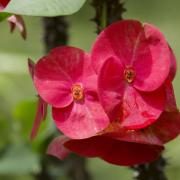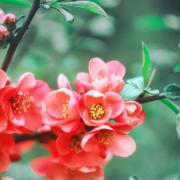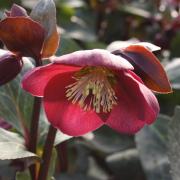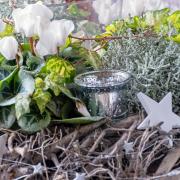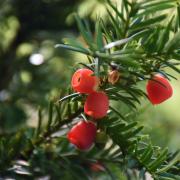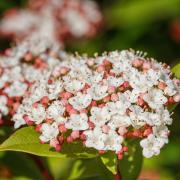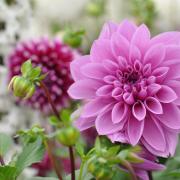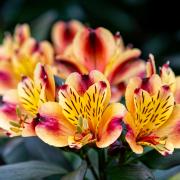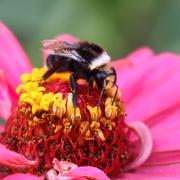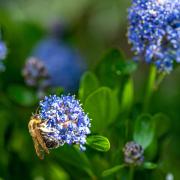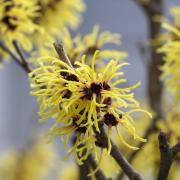Andrea Cowan takes a moment to reflect at one of Britain’s ancient and most loved holy wells

Chalice Well and its garden is nestled in a valley between Chalice Hill and Glastonbury Tor in the Vale of Avalon. The site is described as a ‘garden of many rooms’, each with its own quality reflected in the planting and features but all providing quiet and reflective areas and ultimately leading you through to the heart of the garden – the well itself.
I was privileged to have a guided tour by Natasha who has worked here for 16 years, passionate and committed to the Chalice Well. You enter through a wrought iron gate featuring the Vesica Piscis, an ancient sacred geometric symbol of two interlocking circles that appears throughout the garden. The gate opens onto a pergola path which in the summer, I’m informed, is covered with fragrant wisteria and roses.
To the right is the Vesica Pool, lying at the foot of the garden. It provides the first sight of the spring water travelling through a seven bowl flowform (water sculpture), set in a rockery, cascading into the two circular pools below. Allowed to flow completely naturally, the water creates a perfect figure-of-eight in each bowl before flowing into the next. Amazingly, in the third and eighth bowls the water circulation is timed and counted so that it circulates at 18 and 72 times per minute: the rates of the breath and the heartbeat!
Above the pool stand two ancient yews, considered to be the guardians of the garden. Yews have great significance in ancient lore and are often planted in church yards and sacred sites. There are several in the Chalice Well gardens, but these particularly appealed to me: they are father and son, the smaller one grown from a spur sent underground by the original tree, believed to be around 700 years old.
Beyond the trees is the walled courtyard housing King Arthur’s Court and the Healing Pool. You can sit quietly under the canopy of a large yew tree, amongst the ivy, woodland ferns and shade-loving plants. The shallow pool, with foundations traced back to the 1700s, is visited by people for the healing properties of the waters. You can still walk and cool your feet in the mineral-rich water flowing from a vivid red waterfall.
A flight of steps leads to the next ‘room’; a serene sunken garden edged with box hedging. Here you can actually drink the water from a Lions Head fountain. It is piped directly from the source of the well and quite a sobering thought that the water you sip has been in the earth for some 23,000 years.
Behind the Lion’s Head stands a Holy Thorn Tree, long associated with the legend of Joseph of Arimathea, which fittingly flowers twice a year at Christmas and Easter.
From here you follow a blue lias stone path, embedded with ammonite fossils and lined with flower beds planted in the style of a traditional cottage garden: delphiniums, hollyhocks and calendula in harmonious purple, blue, pink and white hues.
The path leads to the inner sanctuary containing the well. It is incredibly peaceful, sheltered by a beautiful bay laurel and female yew trees, with ferns, violas, hostas, hellabores, lily-of-the-valley, snowdrops and a magnolia providing a calm and serene backdrop. Archaeological evidence suggests that for over two thousand years people have gathered here to drink the water and worship, many believing that the spring has its own spirit.
The striking and intricate well lid was designed by Frederick Bligh Bond and presented as a gift in 1919. Representing the overlapping of the inner and outer worlds, it features the Vesica Piscis crafted in metal. A rather nice aside is that the metal work for the design was the first thing made by a British foundry after World War One – the perfect symbol of peace perhaps.
Above the main garden is a meadow, approached through a living willow arch, providing stunning views of the surrounding countryside. There are benches and secluded seats dotted throughout the gardens, some hidden under arbours of clematis and roses, others tucked into corners – all perfect for quiet contemplation!
The garden is lovely to visit in its own horticultural right and I want to return to see it in each season. I visited with the first signs of spring: snowdrops and crocuses, and even an early primrose. I can only imagine what it looks like in full summer bloom. But I also want to come back for another reason - I left feeling a little calmer and refreshed. I can’t quite define it but there is an air of something rather wonderful here.
Points of interest
The spring water has a high iron content leaving a red deposit on everything it touches.
According to Christian mythology the well sprung from the ground where Joseph of Arimathea, the great-uncle of Jesus, buried the Holy Grail – the chalice that Jesus drank from at the Last Supper and that caught drops of his blood during the Crucifixion
A young visionary, Wellesley Tudor Pole, was profoundly affected by his first visit to Chalice Well in 1902. In 1959 he managed to acquire the site and founded the Chalice Well Trust, a charity to safeguard and protect the well and 12 acres of both public and private gardens. His vision was that all people, regardless of religious belief, race or class, would be able to come and find quiet contemplation and inspiration
The two ley lines, Michael and Mary, cross and intercept under King Arthur’s Court
5,000 visitors come annually from all over the world
Events
Check the website for an annual programme of events including late night garden openings with music, concerts, retreats, meditation and community gatherings.
Open to everyone, ‘Wheel of the year’ meditations follow nature’s cycle including Spring and Autumn Equinoxes, Summer and Winter Solstices, First Stirring, Flowering, Fruition and Harvest. There is also a series of Chalice Well Essences Workshops for practitioners, healers and therapists.
The Silent Minute: This was established by Wellesley Tudor Pole with the support of the Government, King George VI and the BBC during the Second World War. The aim was to dedicate a daily minute to pray for peace. Beginning in 1940, a minute’s silence was signalled by the chiming and striking of Big Ben every evening at 9pm.
The practice is still honoured at the Chalice Well with a daily silent minute at 12pm and 3pm, signalled by the ringing of an old school bell.




